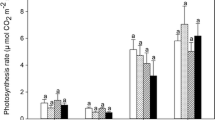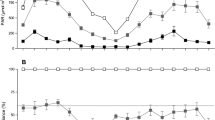Summary
In order to document the natural CO2 environment of the moss Hylocomium splendens, and ascertain whether or not the moss was adapted to this, and its interactions with other microenvironmental factors, two studies were carried out. Firstly, the seasonal variations of CO2 concentration, photosynthetically active radiation (PAR), tissue water content and temperature were measured in the natural microenvironment of H. splendens in a subarctic forest during the summer period (July–September). Secondly, the photosynthetic responses of the species to controlled CO2 concentrations, PAR, temperature, and hydration were measured in the laboratory. CO2 concentrations around the upper parts of the plant, when PAR was above the compensation point (30 μmol m−2 s−1), were mostly between 400 and 450 ppm. They occasionally increased up to 1143 ppm for short periods. PAR flux densities below saturating light levels for photosynthesis (100 μmol m−2 s−1), occurred during 65% (July), 76% (August) and 96% (September) of the hours of the summer period. The temperature optimum of photosynthesis was 20° C: this temperature coincided with PAR above the compensation point during 5%, 6% and 0% of the time in July, August and September, respectively. Optimal hydration of tissues was infrequent. Hence PAR, temperature and water limit CO2 uptake for most of the growing season. Our data suggest that the higher than normal ambient CO2 concentration in the immediate environment of the plant counteracts some of the limitations in PAR supply that it experiences in its habitat. This species already experiences concentrations of atmospheric CO2 predicted to occur over the next 50 years.
Similar content being viewed by others
References
Bazzaz FA, Paolillo DJ, Jagels RH (1969) Photosynthesis and respiration of forest and alpine populations of Polytrichum juniperinum. The Bryologist 73:579–585
Björkman O (1981) Responses to different quantum flux density. In: Lange OL, Nobel PS, Osmond CB, Ziegler H (eds). Physiological Plant Ecology I. Responses to the Physical Environment, Part A. (Encyclopedia of Plant Physiology New Series Volume 12A) Springer, Berlin Heidelberg New York, pp 57–107
Callaghan TV, Collins NJ, Callaghan CH (1978) Photosynthesis, growth and reproduction of Hylocomium splendens and Polytrichum commune in Swedish Lapland. 4 Oikos 31:78–88
Carlyle JC, Than UB (1988) Abiotic controls of soil respiration beneath an eighteen-year-old Pinus radiata stand in southeastern Australia. J Ecol 76:654–662
Collins NJ (1977) The growth of mosses in two contrasting communities in the maritime Antarctic: measurements and prediction of net annual production. In: Llano GA (ed) Adaptations within Antarctic Ecosystems. Smithsonian Institution, Washington, D.C., pp 921–923
Green TGA, Snelgar WP (1982) A comparison of photosynthesis in two thalloid liverworts. Oecologia 54:275–280
Heal OW (1979) Decomposition and nutrient release in even-aged plantations. In: Ford ED, Malcolm DC, Atterson J (eds) The Ecology of Even-aged Forest Plantations. Proceedings of the Meeting of Division I. International Union of Forest Research Organization, Edinburgh 1978. Institute of Terrestrial Ecology, Cambridge, pp 257–291
Hébant C (1977) The conducting tissues of bryophytes. AR Ganter, Vaduz
Kappen L (1988) Ecophysiological relationships in different climatic regions. In: Galun M (ed) CRC handbook of lichenology. Volume II. CRC Press, Boca Raton, pp 37–100
Lange OL, Kappen L (1972) Photosynthesis of lichens from Antarctica. In: Llano GA (ed) Antarctic terrestrial biology. American Geophysical Union, Washington, D.C., Antarctic research series 20:83–95
Lemon ER (1983) CO2 and plants. The response of plants to rising levels of atmospheric carbon dioxide. Westview Press, Boulder, Colorado
Lieth H (1960) Über den lichtkompensationspunkt der Landpflanzen. Planta 54:530–576
Melillo J, Callaghan TV, Woodward FI, Salati E, Sinha SK (1990) Scientific Assessment of Climate Change: 10. Effects on Ecosystems. WMO, UNEP, Intergovernal Panel on Climate Change, Report Prepared for IPCC by Working Group 1, pp 287–310
Nobel PS (1991) Physicochemical and environmental plant physiology. Academic Press Inc., San Diego, pp 455–465
Proctor MCF (1982) Physiological Ecology: Water Relations, Light and Temperature Responses, Carbon Balance. In: Smith AJE (ed) Bryophyte Ecology. Chapman and Hall, London New York, pp 333–381
Schlentner RE, Van Cleve K (1985) Relationships between CO2 evolution from soil, substrate temperature, and substrate moisture in four mature forest types in interior Alaska. Can J For Res 15:97–107
Silvola J (1985) CO2 dependence of photosynthesis in certain forest and peat mosses and simulated photosynthesis at various actual and hypothetical CO2 concentrations. Lindbergia 11:86–93
Sonesson M (1989) Water, light and temperature relations of the epiphytic lichens Parmelia olivacea and Parmeliopsis ambigua in northern Swedish Lapland. Oikos 56:402–415
Sonesson M, Lundberg B (1974) Late Quaternary forest development in the Torneträsk area, northern Sweden. 1. Structure of modern forest ecosystems. Oikos 25:121–133
Sonesson M, Schipperges B, Carlsson BÅ (1992) Seasonal patterns of photosynthesis in alpine and subalpine populations of the lichen Nephroma arcticum. Oikos 65:3–12
Strain BR, Cure JD (eds) (1985) Direct effects on increasing carbon dioxide on vegetation. U.S. Dept. of Energy, Office of Energy Research, Durham, NC
Tissue DT, Oechel WC (1987) Response of Eriophorum vaginatum to elevated CO2 and temperature in Alaskan tussock tundra. Ecology 68(2):401–410
Zar JH (1984) Biostatistical analysis. Prentice-Hall, Englewood Cliffs
Author information
Authors and Affiliations
Rights and permissions
About this article
Cite this article
Sonesson, M., Gehrke, C. & Tjus, M. CO2 environment, microclimate and photosynthetic characteristics of the moss Hylocomium splendens in a subarctic habitat. Oecologia 92, 23–29 (1992). https://doi.org/10.1007/BF00317258
Received:
Accepted:
Issue Date:
DOI: https://doi.org/10.1007/BF00317258




